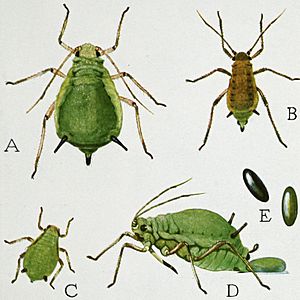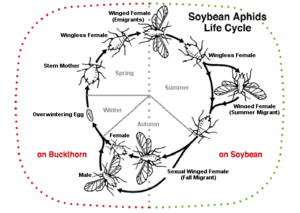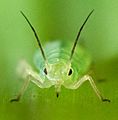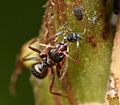Aphid facts for kids
Quick facts for kids Aphids |
|
|---|---|
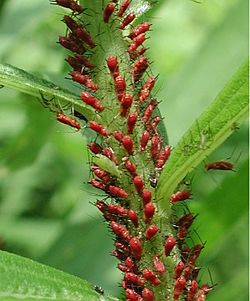 |
|
| Scientific classification | |
| Kingdom: | |
| Phylum: | |
| Class: | |
| Order: | |
| Suborder: |
Sternorrhyncha
|
| Superfamily: |
Aphidoidea
|

Aphids are tiny bugs that love to feed on plants. They are sometimes called "plant lice." These small insects can cause a lot of damage to plants, even more than other insects. There are about 4,000 different species of aphids around the world.
About 250 of these species are considered serious pests for farms and forests. They can also be a big bother for gardeners. Aphids are quite small, usually between 1 and 10 mm long.
Luckily, aphids have many natural enemies! These include helpful insects like lady beetles (also known as ladybugs), hoverfly larvae, and lacewings. Other enemies are larvae of the aphid midge, crab spiders, and even special fungi that eat insects.
Aphids can be found in many places on Earth, but they are most common in areas with mild weather, called temperate zones. They can travel long distances through the air, sometimes spreading to new places. For example, the lettuce aphid traveled from New Zealand all the way to Tasmania. People can also accidentally spread aphids by moving plants that have them.
What Do Aphids Look Like?
Most aphids have soft bodies that can be green, black, brown, pink, or even almost clear. They have antennae with up to six parts. Aphids eat by using special sucking mouthparts called stylets. These stylets are covered by a sheath called a rostrum, which acts like a straw to help them drink. They also have long, thin legs with two small claws on each foot.
Many aphids have two small tubes on their back, called "cornicles." When an aphid feels threatened, it can release a quick-hardening fluid from these tubes. This fluid helps protect them from enemies. Some aphids can also make other defensive chemicals.
Aphids have a small, tail-like part called a "cauda" near their rear end. They also have two compound eyes, which are made up of many tiny lenses, helping them see.
When there isn't enough good food, or when too many aphids are crowded together, some aphid species can grow wings. These winged aphids, called "alates," can then fly away to find new plants and food sources. In some aphid types, the mouthparts or eyes might be smaller or even missing.
What Do Aphids Eat?
Many aphid species are "monophagous," meaning they only eat one specific type of plant. But others, like the green peach aphid (Myzus persicae), are not picky and can feed on hundreds of different plant species!
Aphids feed on sap from the phloem vessels inside plants. Phloem is like the plant's circulatory system, carrying nutrients. The sap inside these vessels is under high pressure, so when an aphid pokes its stylet in, the sap is pushed right into the aphid's mouth.
Plant sap isn't a perfect diet for aphids. It has a lot of sugar but not enough of certain amino acids that aphids need to grow. To solve this, aphids have tiny helpers inside their bodies called bacteriocytes. These are special cells that contain helpful bacteria. These bacteria turn the aphid's waste into the essential amino acids that the aphid needs.
As aphids feed, they can sometimes pass plant viruses from one plant to another. These viruses can harm or even kill important crops like potatoes, cereals, sugarbeets, and citrus plants.
Images for kids
-
Forewing of the early Middle Triassic (early Anisian) aphid Vosegus triassicus
-
Front view of wheat aphid, Schizaphis graminum, showing the piercing-sucking mouthparts
-
Parasitoid braconid wasp ovipositing in black bean aphid
See also
 In Spanish: Aphidoidea para niños
In Spanish: Aphidoidea para niños


